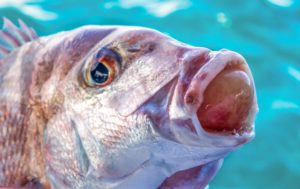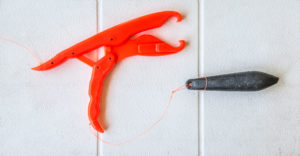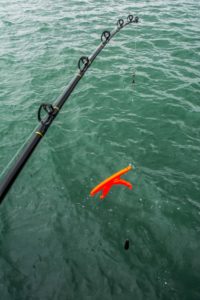
When fishing in water deeper than 20 metres some species of fish suffer from barotrauma when reeled to the surface. Barotrauma is where a fish can’t adapt to the change in water pressure quickly enough and the gas in their swim bladder expands as they are brought to the surface on a fisher’s line. Some species like kahawai and kingfish are more adaptable and are less susceptible to barotrauma. Snapper, unfortunately, are not a species that are as adaptable and are more likely to suffer the effects of barotrauma.
This condition has been studied and several attempts to help fish survive have been trialled and developed. One commercial product developed in the USA is called the ‘SeaQualizer’ and is like a pair of jaws that fixes to your line and then to the fish’s jaw ($60 USD). The fish is lowered on your line and when the fish hits the approximate depth set, the jaws release and the fish swims away.
A similar descender rig that involves a hook and heavy (16-20oz) weight has been commercially produced in Australia and had good success at being able to provide a viable option to return fish back to the depth they were hooked. A barbless hook is attached to a heavy sinker and then a loop is attached to the bend in the hook. A fishing line is attached to the loop so the rig can descend to the seafloor, carrying the fish which has been hooked through the top lip. A sharp tug on the line pulls the hook out of the fish’s top lip and it swims free.


The other style of descender rig developed by Kiwi marine scientist John Holdsworth has the same basic set at an affordable price. Instead of a barbless hook, it incorporates a pair of Fish Grips. Fish Grips are a pair of plastic vice grips that are attached to the top or lower lip. A hole can be drilled in the grip’s top handle so that the line can be attached to it. Another short (40cm) section of mono is attached to the lower handle and then the heavy weight. When returning a fish back to the depth it came from the grips are fastened to the fish’s jaw and both are carefully placed in the water. Gently ease the line out so the weight can carry the fish down to the depths. Once on the bottom, a sharp jerk on the line will release the grip so the fish can swim free.
Having a dedicated rod set up beforehand is a good idea as the length of time it takes to return the fish can make a big difference to its survival.
As we realise how finite and delicate our ocean resources are we need to be continually assessing better ways to fish. While this process might feel awkward at first, over time you will become well-practised at releasing fish in good condition.
We need to protect and conserve what we have. If you catch fish in water over 10m there is the likely that fish will suffer some effects of barotrauma. LegaSea encourages you to have a go at using the descender rig to reduce your impact on the marine environment.


